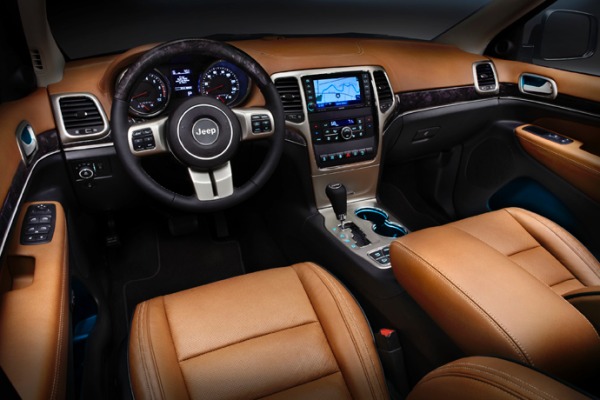
Can a single vehicle save an entire car company? Not hardly. Although the 2011 Jeep Grand Cherokee was an acknowledged Hail Mary for Chrysler as it began to crumble, and is also heir to a hallowed nameplate that rode the SUV craze to huge success. And the story has a happy ending, at least for the first post-Fiat chapter, since the all-new Grand Cherokee has largely won over the press and is a sales success.
And though the automaker was being counted out, Chrysler was creating cutting-edge tech, even if being a trailblazer sometimes led down a dead-end. Such is the case with Chrysler's deal with Sirius Backseat TV (still only three channels!), and later with its ill-fated affiliation with Qualcomm to bring live broadcast FLO TV to vehicles. And it was the first to offer in-car Wi-Fi via Autonet Mobile, before many other competitors jumped on the in-car broadband bandwagon.
The latest iteration of the Jeep Grand Cherokee is laden with most of this tech. But for the vehicle that represents its renewal, Chrysler went with a super low-key Alpine system -- it doesn't even have logos -- that nonetheless stands out from the crowd.
The Setup
The Alpine system in the 2011 Jeep Grand Cherokee Limited 4x4 I tested consists of 10 speakers powered by 506 watts. These include a 2.5-inch speaker in the center of the dash, a 1-inch tweeter in the "mirror patch" in each front door, a 6x9-inch full-range speaker lower in each front door, a 6.5-inch full-range in each rear door, a 2.5-inch speaker in each C pillar and a 10-inch subwoofer in the passenger-side wall of the rear cargo area.
The Sound
As with every vehicle we sound-check, I sat in the Jeep Grand Cherokee Limited, with the engine running and while parked, and listened to my list of test tracks. These songs allow me to gauge clarity/lack of distortion, tonal balance, timbre, tonal accuracy, soundstaging, imaging and dynamics. I also use several non-audio tracks to test for staging/imaging, linearity and absence of noise. If you want to know more about this testing procedure -- and what those fancy audiophile words mean -- check out the Edmunds.com article Sound Advice.
The Alpine system in the Grand Cherokee scored well above average in every sound quality category, and hit even higher marks in certain ones with particular tracks. Overall, tonal balance was smooth, and timbre and tonal accuracy were close enough to lifelike to please all but the most demanding audiophiles. Soundstaging and imaging were also excellent, which is typically the result of well-placed front tweeters (in this Jeep they are slightly angled towards the rear of the vehicle) and a dedicated center-channel speaker.
And except for the usual midbass boom that's endemic to OEM car audio -- you're essentially sitting in a speaker enclosure, after all -- bass was remarkably well-behaved. And the subwoofer provided low end that gave the music the kind of palpable impact that separates really good automotive sound systems from the poseurs. My only complaint is that the system had a hard time faithfully reproducing some of most demanding test tracks, particularly those with strong midbass. But that's usually the case with all but the best stock sound systems. And it handled the toughest treble parts with ease.
The Sources
The Grand Cherokee I tested -- an optioned-out press vehicle with a sticker that tipped the scales at $48,145, almost 10 grand over the base price -- had the Media Center 730N head unit. For a reasonable $750, it includes a CD/DVD slot behind a fold-down 8.5-inch touch screen, a 30GB hard drive that can hold over 4,000 song files (the rest of the disk space is for a HDD nav system) and iPod integration. Of course, AM and FM radio is also onboard, and Chrysler throws in one year of Sirius satellite radio. The only thing missing is Bluetooth audio.
The Media Center head unit also has an aux-in jack and a USB port, but the latter isn't used for iPod integration, as is the case with more and more vehicles these days. Instead you have to plug your Apple player or phone into a proprietary cable in the glove box. Once you do, access to an iPod's contents is via the in-dash touch screen, and pretty straightforward and painless, although response time after touching a button could be faster for us impatient types. A List Jump feature allows typing in what you're looking for alphabetically instead of scrolling through a long list of menu items. But it only skips to menu items by the first letter in the item's name. So if you have, say, lots of songs that start with R, you have to wade through them to get to what you want.
Music files on a USB drive follow the same menu convention as those on an iPod. But Chrysler systems of this type continue to force the user to inexplicably load the files from a USB drive onto the hard drive before they can be listened to. Letting owners plug in a USB drive and rock on would eliminate this unnecessary extra step.
What We Say
The Alpine system in the 2011 Jeep Grand Cherokee Limited 4x4 that we tested is atypical of those in most SUVs in this class in that it's standard (at this trim level, at least) and doesn't regard audio as an afterthought. Many high-end sedans -- even with premium systems and with more speakers and power -- don't sound this good.
Just goes to show that you don't need lots of hardware, or prominent logos, to create great factory sound. And what car designers and a car company can achieve under pressure.
The Scores
Sound: A-
Source Selection: A-
iPod Integration: B-
Cost: A